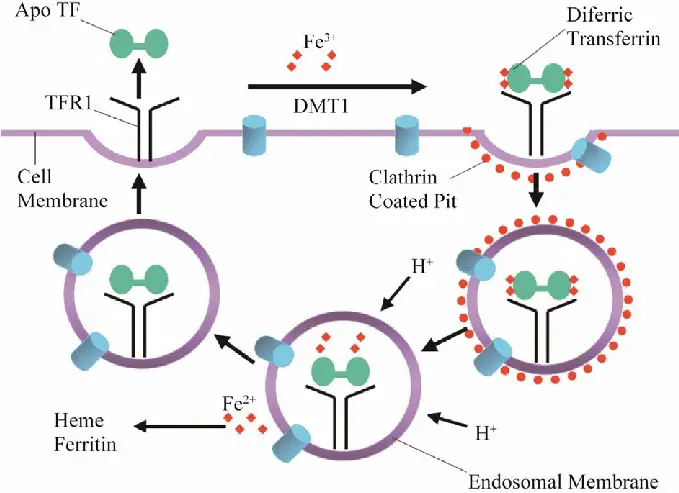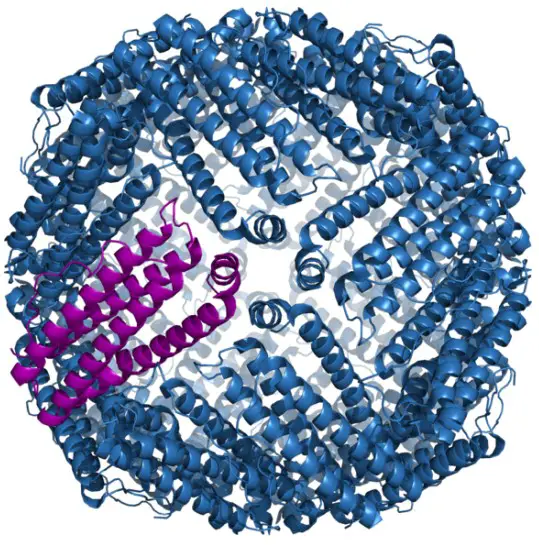Iron plays a pivotal role in our body, contributing to various essential functions including oxygen transport, DNA synthesis, and energy metabolism. However, the management of this crucial mineral hinges on the interplay between two proteins: ferritin and transferrin. These proteins not only serve distinct functions but also hold the key to understanding an individual’s iron status and overall health.
Ferritin acts as the body’s iron storage protein, holding onto iron when it’s in abundance, and releasing it when needed. Transferrin, on the other hand, is the transporter, moving iron to where it’s needed throughout the body. The difference between ferritin and transferrin lies in their roles and the way they interact with iron in the body, making them vital markers for diagnosing and managing iron-related disorders.
This article delves into the specifics of ferritin and transferrin, shedding light on their importance, the nuances of their functions, and the implications of their levels on one’s health. By understanding these proteins, one can gain insights into the delicate balance of iron metabolism and its impact on various bodily functions.

Iron in the Body
Essential Functions
Iron is a vital mineral that plays several crucial roles in the human body. It’s primarily known for its contribution to oxygen transport. Iron helps form hemoglobin in red blood cells, which carries oxygen from the lungs to the rest of the body. Without sufficient iron, the body can’t make enough healthy oxygen-carrying red blood cells, leading to conditions like anemia.
Role of Iron in Health
Iron’s importance extends beyond oxygen transport. It’s also essential for:
- Energy production: Iron is a key component of mitochondria, the powerhouse of cells, where it helps convert nutrients into ATP, the energy currency of the cell.
- Immune function: Iron supports the development of immune cells, particularly lymphocytes, that defend the body against pathogens.
- Brain function: Iron is crucial for brain health, contributing to neurotransmitter production, myelin sheath formation, and cognitive development.
Regulation Mechanisms
The body carefully regulates iron levels through a complex system known as iron homeostasis. This system balances iron absorption, storage, and recycling to prevent both iron deficiency and iron overload.
Overview of Iron Homeostasis
Key points in iron regulation include:
- Absorption: Iron is absorbed in the diet through the small intestine. The body adjusts the amount of iron absorbed based on its needs.
- Storage and Recycling: Excess iron is stored in the liver, spleen, and bone marrow in the form of ferritin. The body also recycles iron from old red blood cells.
- Transport: Iron is transported throughout the body bound to a protein called transferrin.
This delicate balance ensures that the body has enough iron for its needs without reaching toxic levels.
Ferritin
What is Ferritin?
Ferritin is a protein that stores iron within cells, acting as a buffer against iron deficiency and overload. It releases iron when needed, ensuring a steady supply for the body’s functions.
Definition and Function
Ferritin’s main roles are to:
- Store iron: Ferritin keeps iron in a soluble, non-toxic form.
- Release iron: It releases iron in a controlled manner to meet the body’s demands.
Ferritin Levels
The amount of ferritin in the blood reflects the total iron stored in the body. Doctors often measure ferritin levels to assess iron status.
Normal Ranges and Significance
- Normal ferritin levels vary by age and sex but generally range from 20 to 500 nanograms per milliliter.
- Significance: Ferritin levels help diagnose iron disorders, including iron deficiency anemia and hemochromatosis, an iron overload condition.
High Ferritin
Elevated ferritin levels can indicate several conditions.
Causes and Implications
- Inflammation: Ferritin is an acute-phase reactant, meaning its levels can rise in response to inflammation.
- Iron overload: Conditions like hemochromatosis lead to excessive iron storage.
- Liver disease: High ferritin can signal liver damage, as ferritin is stored in the liver.
Low Ferritin
Low ferritin levels typically indicate iron deficiency.
Causes and Health Effects
- Iron deficiency anemia: The most common cause of low ferritin. Symptoms include fatigue, weakness, and pale skin.
- Poor diet: Insufficient dietary iron reduces ferritin levels.
Transferrin
What is Transferrin?
Transferrin is a plasma protein that binds and transports iron throughout the bloodstream, delivering it to where it’s needed.
Definition and Role in Iron Transport
Transferrin’s key functions include:
- Iron delivery: Transferrin transports iron to various cells, especially bone marrow cells for hemoglobin production.
- Regulation of iron absorption: It helps regulate iron uptake from the intestine.
Transferrin Levels
Transferrin levels are indicative of the body’s iron transport capacity and are used to assess iron status.
Understanding Normal and Abnormal Levels
- Normal levels typically range from 200 to 400 milligrams per deciliter.
- Abnormal levels can indicate iron disorders, such as iron deficiency or overload.
High Transferrin
Increased transferrin levels often point to iron deficiency.
Causes and What it Indicates
- Iron deficiency: The body produces more transferrin to maximize iron transport from limited sources.
- Pregnancy: Increased blood volume during pregnancy can lead to higher transferrin levels.
Low Transferrin
Reduced transferrin levels can be a sign of several conditions.
Reasons and Potential Health Impacts
- Iron overload: In iron overload, the body reduces transferrin production.
- Chronic diseases: Certain chronic conditions can suppress transferrin production.

Ferritin vs. Transferrin
Structural Differences
Comparison of Physical Properties
Ferritin and transferrin, while both integral to iron management in the body, have distinct structural characteristics. Ferritin is a large protein complex that can store up to 4,500 iron atoms in its hollow cavity, making it effectively the body’s iron storage unit. Its structure allows it to store iron safely and release it in a controlled manner. Transferrin, on the other hand, is a smaller, globular glycoprotein that binds to iron very tightly but only carries two iron atoms at a time. This tight binding is crucial for its role in transporting iron through the blood to various tissues.
Functional Distinctions
Diverging Roles in Iron Metabolism
The functional differences between ferritin and transferrin highlight their complementary roles in iron metabolism. Ferritin, residing mainly in cells’ cytoplasm, safeguards the body against iron’s potential toxicity by storing it when in excess and supplying it when needed. Transferrin circulates in the bloodstream, binding free iron that has been absorbed from the diet or released from stores, and delivering it to cells across the body, including those in the liver, spleen, and bone marrow.
Clinical Significance
How Levels of Each are Used in Diagnosis
The levels of ferritin and transferrin in the blood provide key insights into a person’s iron status and overall health. High ferritin levels may indicate iron overload or inflammation, while low levels suggest iron deficiency. Elevated transferrin levels are typically seen in iron deficiency, as the body attempts to transport as much iron as possible, whereas low levels may indicate iron overload or chronic disease. These distinctions make ferritin and transferrin crucial markers in diagnosing various iron-related conditions.
Testing and Interpretation
Diagnosing Iron Disorders
Tests for Ferritin and Transferrin
To diagnose iron disorders, healthcare providers commonly order blood tests to measure ferritin and transferrin levels. The ferritin test is straightforward, measuring the concentration of ferritin in the blood. The transferrin test, or total iron-binding capacity (TIBC) test, measures how much iron can be carried through the blood, indirectly indicating transferrin levels.
Interpreting Results
What Various Levels Suggest About Health
Interpreting the results of these tests can help pinpoint the nature of an iron disorder:
- High ferritin with low transferrin suggests iron overload.
- Low ferritin with high transferrin indicates iron deficiency.
- Both elevated could point to anemia of chronic disease where iron is available but not utilized properly.
Understanding these results is crucial for accurate diagnosis and treatment planning.
Managing Imbalances
Dietary Considerations
Influence of Diet on Ferritin and Transferrin Levels
Diet plays a significant role in managing ferritin and transferrin levels. For individuals with low ferritin (iron storage), increasing intake of iron-rich foods such as red meat, poultry, fish, legumes, and fortified cereals can help boost iron stores. Vitamin C can enhance the absorption of iron, so including vitamin C-rich foods like citrus fruits, strawberries, and bell peppers in meals can be beneficial. For those with high transferrin levels due to iron deficiency, the same dietary approach applies, focusing on enhancing iron intake and absorption.
Medical Interventions
Treatments for Managing Abnormal Levels
Medical interventions for managing abnormal ferritin and transferrin levels vary based on the underlying condition:
- Iron supplementation: Often prescribed for iron deficiency, supplements can help increase ferritin levels and decrease transferrin levels.
- Phlebotomy: The removal of blood can be effective for conditions like hemochromatosis, reducing iron overload and lowering ferritin levels.
- Iron chelation therapy: Used in cases of severe iron overload, chelators bind to excess iron, allowing it to be excreted from the body.
Managing iron levels through these interventions requires careful monitoring by healthcare professionals to avoid shifting from one extreme to another. Balancing ferritin and transferrin levels is key to maintaining optimal iron metabolism and overall health.
Frequently Asked Questions
What is Ferritin?
Ferritin is a protein that stores iron inside cells, ensuring the body has a reserve of this essential mineral for future use. Its levels in the blood reflect the amount of stored iron, making it a crucial marker for diagnosing conditions like anemia or iron overload.
How does Transferrin function?
Transferrin is the main iron transport protein in the blood, responsible for delivering iron from the diet and storage sites to all body cells where it’s needed. Its levels can indicate iron deficiency or overload, providing key information on a person’s iron metabolism status.
Why are Ferritin and Transferrin levels important?
Ferritin and transferrin levels are critical for assessing an individual’s iron status. High or low levels of these proteins can indicate iron deficiency, anemia, or iron overload disorders, such as hemochromatosis, guiding appropriate treatment and dietary recommendations.
Can diet affect Ferritin and Transferrin levels?
Yes, diet plays a significant role in influencing ferritin and transferrin levels. Iron-rich foods can increase ferritin, while certain conditions and dietary choices may affect transferrin levels. It’s essential to balance iron intake to maintain optimal levels of these proteins.
Conclusion
Understanding the difference between ferritin and transferrin offers a window into the complex world of iron metabolism. These proteins do more than just manage iron; they provide valuable insights into one’s health, guiding both diagnosis and treatment for iron-related disorders. Recognizing their roles and the implications of their levels can help individuals navigate their health journey more effectively.
As we continue to uncover the intricacies of how our body manages iron, the significance of proteins like ferritin and transferrin cannot be overstated. Their study not only aids in the treatment of current conditions but also paves the way for future research, potentially unlocking new avenues for managing health and disease.

